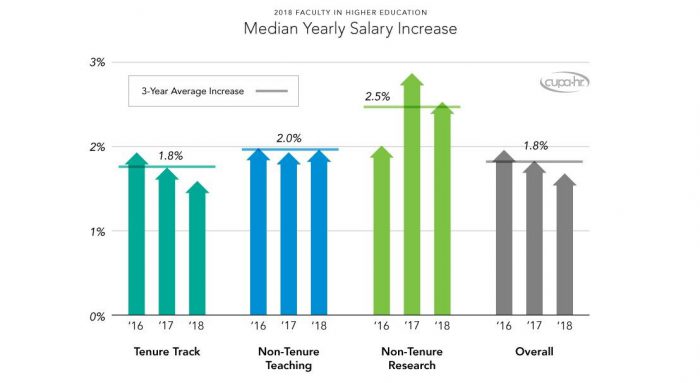PRESS RELEASE
FOR IMMEDIATE RELEASE
March 28, 2018
Non-Tenure Faculty See Higher Pay Raises Than Tenure-Track Faculty in 2017-18
Faculty salaries increased by 1.7 percent over the past year, with non-tenure research faculty seeing the highest increase, and tenure-track faculty seeing the lowest, according to the 2018 CUPA-HR Faculty in Higher Education Report.
Salary increases for tenure-track faculty have declined over the past three years, from near-parity with non-tenure teaching faculty and non-tenure research faculty in 2016, to progressively lower increases by 2018. Yearly salary increases for non-tenure teaching faculty have remained relatively consistent (around 2 percent) over the same period. Non-tenure research faculty have seen a significant jump in salaries for the past two years, outpacing both tenure-track and non-tenure teaching faculty salary increases.

Other Findings:
- Adjuncts are paid the least in associate’s institutions, where they make up nearly two-thirds of all faculty, and the most in doctoral institutions, where they make up about one-third of all faculty.
- For department heads, public and doctoral institutions are more likely to provide pay increases in the form of a salary supplement and/or summer salary, whereas master’s and baccalaureate institutions are more likely to provide course relief than salary supplements.
- For all types of faculty, the representation of women and minorities decreases with increases in rank from assistant professor to professor. Disciplines in which women have the highest representation also often have the highest salary gaps. In contrast, some disciplines in which women have the lowest representation have the lowest salary gaps. The exception is in non-tenure research positions, where women have very low representation, but at the rank of new assistant professor are paid significantly more than men. This could reflect an effort to recruit and retain women in these positions. For most faculty types and ranks, minorities are paid similarly to or more than their non-minority (White) peers.
- Health professions and nursing top the list for the most new faculty hires in 2017-18.
A total of 238,698 full-time faculty positions were reported for this year’s survey, including 9,419 faculty identified as department heads, as well as 70,000 adjunct faculty positions. To learn more about the Faculty in Higher Education Survey, read the overview. Salaries and detailed trend information are available for purchase in the full report.
About CUPA-HR
CUPA-HR is the recognized authority on compensation surveys for higher education, with its salary surveys designed by higher ed HR professionals for higher ed HR professionals and other campus leaders. CUPA-HR’s Faculty in Higher Education Salary Survey is the only faculty survey that provides data for the current academic year, maintains institution anonymity, collects data by rank and specific discipline, and collects comprehensive demographic data. Learn more about CUPA-HR research.
CUPA-HR serves higher education by providing the knowledge, resources, advocacy and connections to achieve organizational and workforce excellence. Headquartered in Knoxville, Tennessee, and serving 25,000 HR professionals and other campus leaders at more than 2,000 member institutions and organizations around the country and abroad, the association offers learning and professional development programs, higher education salary and benefits data, extensive online resources and just-in-time regulatory and legislative information.
Contact:
Missy Kline, Content Manager – Communications and Marketing
[email protected]
877-287-2474


